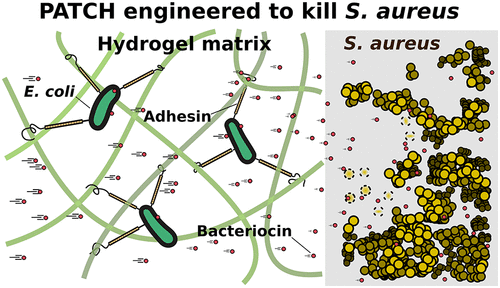当前位置:
X-MOL 学术
›
ACS Synth. Biol.
›
论文详情
Our official English website, www.x-mol.net, welcomes your
feedback! (Note: you will need to create a separate account there.)
Engineered Living Materials Based on Adhesin-Mediated Trapping of Programmable Cells.
ACS Synthetic Biology ( IF 3.7 ) Pub Date : 2020-03-03 , DOI: 10.1021/acssynbio.9b00404 Shuaiqi Guo , Emilien Dubuc , Yahav Rave , Mick Verhagen , Simone A E Twisk , Tim van der Hek , Guido J M Oerlemans , Maxime C M van den Oetelaar , Laura S van Hazendonk , Mariska Brüls , Bruno V Eijkens , Pim L Joostens , Sander R Keij , Weizhou Xing , Martijn Nijs 1 , Jitske Stalpers 1 , Manoj Sharma , Marieke Gerth , Roy J E A Boonen , Kees Verduin 1 , Maarten Merkx , Ilja K Voets , Tom F A de Greef 2
ACS Synthetic Biology ( IF 3.7 ) Pub Date : 2020-03-03 , DOI: 10.1021/acssynbio.9b00404 Shuaiqi Guo , Emilien Dubuc , Yahav Rave , Mick Verhagen , Simone A E Twisk , Tim van der Hek , Guido J M Oerlemans , Maxime C M van den Oetelaar , Laura S van Hazendonk , Mariska Brüls , Bruno V Eijkens , Pim L Joostens , Sander R Keij , Weizhou Xing , Martijn Nijs 1 , Jitske Stalpers 1 , Manoj Sharma , Marieke Gerth , Roy J E A Boonen , Kees Verduin 1 , Maarten Merkx , Ilja K Voets , Tom F A de Greef 2
Affiliation

|
Engineered living materials have the potential for wide-ranging applications such as biosensing and treatment of diseases. Programmable cells provide the functional basis for living materials; however, their release into the environment raises numerous biosafety concerns. Current designs that limit the release of genetically engineered cells typically involve the fabrication of multilayer hybrid materials with submicrometer porous matrices. Nevertheless the stringent physical barriers limit the diffusion of macromolecules and therefore the repertoire of molecules available for actuation in response to communication signals between cells and their environment. Here, we engineer a novel living material entitled "Platform for Adhesin-mediated Trapping of Cells in Hydrogels" (PATCH). This technology is based on engineered E. coli that displays an adhesion protein derived from an Antarctic bacterium with a high affinity for glucose. The adhesin stably anchors E. coli in dextran-based hydrogels with large pore diameters (10-100 μm) and reduces the leakage of bacteria into the environment by up to 100-fold. As an application of PATCH, we engineered E. coli to secrete the bacteriocin lysostaphin which specifically kills Staphyloccocus aureus with low probability of raising antibiotic resistance. We demonstrated that living materials containing this lysostaphin-secreting E. coli inhibit the growth of S. aureus, including the strain resistant to methicillin (MRSA). Our tunable platform allows stable integration of programmable cells in dextran-based hydrogels without compromising free diffusion of macromolecules and could have potential applications in biotechnology and biomedicine.
中文翻译:

基于粘附素介导的可编程细胞捕获的工程化生活材料。
工程生活材料具有广泛的应用潜力,例如生物传感和疾病治疗。可编程单元为生活材料提供了功能基础;然而,它们释放到环境中引起了许多生物安全问题。当前限制基因工程细胞释放的设计通常涉及具有亚微米多孔基质的多层杂化材料的制造。然而,严格的物理屏障限制了大分子的扩散,因此限制了可用于响应细胞及其周围环境之间的通信信号而致动的分子库。在这里,我们设计了一种新颖的生活材料,名为“用于粘附素介导的水凝胶细胞捕获平台”(PATCH)。该技术基于工程E。大肠埃希菌,它显示出一种源自南极细菌的粘附蛋白,对葡萄糖具有很高的亲和力。粘附素稳定地将大肠杆菌锚定在具有大孔径(10-100μm)的葡聚糖基水凝胶中,并将细菌向环境的泄漏减少多达100倍。作为PATCH的一种应用,我们改造了大肠杆菌以分泌细菌素溶葡萄球菌素,该菌素特异性地杀死金黄色葡萄球菌,而提高抗生素耐药性的可能性很小。我们证明了包含这种分泌溶葡萄球菌素的大肠杆菌的生物材料能够抑制金黄色葡萄球菌的生长,包括对甲氧西林(MRSA)耐药的菌株。
更新日期:2020-03-03
中文翻译:

基于粘附素介导的可编程细胞捕获的工程化生活材料。
工程生活材料具有广泛的应用潜力,例如生物传感和疾病治疗。可编程单元为生活材料提供了功能基础;然而,它们释放到环境中引起了许多生物安全问题。当前限制基因工程细胞释放的设计通常涉及具有亚微米多孔基质的多层杂化材料的制造。然而,严格的物理屏障限制了大分子的扩散,因此限制了可用于响应细胞及其周围环境之间的通信信号而致动的分子库。在这里,我们设计了一种新颖的生活材料,名为“用于粘附素介导的水凝胶细胞捕获平台”(PATCH)。该技术基于工程E。大肠埃希菌,它显示出一种源自南极细菌的粘附蛋白,对葡萄糖具有很高的亲和力。粘附素稳定地将大肠杆菌锚定在具有大孔径(10-100μm)的葡聚糖基水凝胶中,并将细菌向环境的泄漏减少多达100倍。作为PATCH的一种应用,我们改造了大肠杆菌以分泌细菌素溶葡萄球菌素,该菌素特异性地杀死金黄色葡萄球菌,而提高抗生素耐药性的可能性很小。我们证明了包含这种分泌溶葡萄球菌素的大肠杆菌的生物材料能够抑制金黄色葡萄球菌的生长,包括对甲氧西林(MRSA)耐药的菌株。











































 京公网安备 11010802027423号
京公网安备 11010802027423号